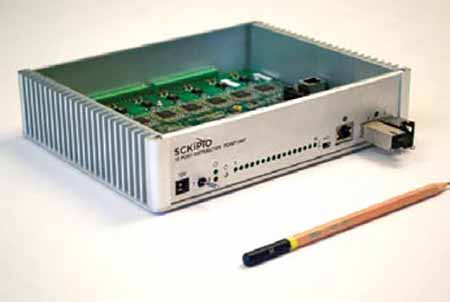New ITU Standard Could Boost 4K Over Telco
GENEVA, SWITZERLAND—The International Telecommunications Union’s approval last month of the G.fast data transmission standard, which can deliver data through copper phone lines at up to 1 Gbps, is good news for proponents of 4KTV. G.fast could make it possible for telcos to provide residential customers with substantial bandwidth upgrades, without running expensive fiber-optic cables directly to their home termination points.
“With 4KTV signals needing anywhere from 15-25 Mbps per channel, boosting home bandwidth so that 4KTV doesn’t eat the lion’s share of the home user’s bandwidth is very important,” said Wes Simpson, president of Telecom Product Consulting in Orange, Conn. and contributor to TV Technology’s Video Networking column. “With G.fast, supporting 4KTV to the home wouldn’t be a problem—as long as the telco’s overall network can cope with the extra traffic on a mass basis.”
G.FAST’S ADVANTAGES
The ITU’s development of G.fast is just the latest milestone in its decades-long efforts to move data through POTS lines at ever faster speeds.

Frank Van der Putten “Our efforts go back to 1997, leading to the acceptance of the ADSL [asymmetric digital subscriber line] standard in 1999,” said Frank Van der Putten, rapporteur for Q4 (Broadband over Metallic Conductors) at ITU-T SG15, also known as the “ITU G.fast group.” (A “rapporteur” is an individual assigned by an organization to report on meetings.) “We are constantly trying to find new ways to get more data throughput on existing twisted-pair lines in order to minimize upgrade costs for our telco members.”
Although G.fast is compatible with VDSL (very-high-bit-rate digital subscriber line) and its VDSL2 successor that delivers up to 100 Mbps over 30 MHz of spectrum, it is not the same technology. “VDSL works by assigning fixed upload/download frequencies on the twisted pair, which can limit delivery speed,” Van der Putten said. “G.fast discards assigned bandwidth in favor of using the entire available spectrum for uploads and downloads, allowing us to move more data in a flexible way. Add the fact that we can expand the spectrum used for G.fast transmissions up to 106 MHz, and there’s a lot more room to move data over twisted pair.”
Another big G.fast advantage is that is “self-installing,” i.e., a technician does not have to upgrade a home subscriber to G.fast. Instead, the consumer is simply provided with a G.fast modem that they connect and configure themselves; just as they do today with ADSL modems. For telcos wanting to provide bandwidth improvements on a budget, G.fast is the technical solution they’re looking for.
THE LIMITS
Of course, every technology comes with limits, and G.fast is no exception. The technology’s Achille’s Heel is distance: G.fast’s performance degrades to 500 Mbps when the twisted pair being used reaches 100 meters (328 feet). It can also be degraded over shorter distances if the path isn’t a “straight loop,” in other words, a line that has any kind of plugs and/or splits added to it.
Get the TV Tech Newsletter
The professional video industry's #1 source for news, trends and product and tech information. Sign up below.
“This is why G.fast makes the most sense in settings such as apartment buildings, where fiber can be brought into the building’s termination point and then distributed over the existing twisted-pair internal network,” said Simpson. “Even in this setting, the distances traveled by POTS connections have to be relatively short, in order to maintain the speeds the telcos want to achieve.”

Sckipio is the first company to enable telecom broadband providers to deliver multiple streams of UHD TV concurrently, and was the first semiconductor company to deliver up to 1Gbps of ultra-broadband of phone lines using the new G.fast broadband standard. G.fast may also be useful in urban areas, where single family dwellings are close together; allowing one fiber to serve a number of houses via twisted-pair connections. But in dispersed areas like suburbs, telcos may be forced to stick with fiber-optic deployment to individual homes.
As a result, G.fast probably won’t become the dominant data transmission option adopted by telcos, but an additional option in their upgrade toolkit. Still, the fact that G.fast works over POTS lines is a major bonus for the telcos; both in terms of capital costs and speed-of-deployment.
LOOKING AHEAD
Last month’s approval of G.fast doesn’t mean that G.fast modems will start popping up in consumers’ homes immediately. In fact, the Broadband Forum’s G.fast certification program is now evaluating compatibility of G.fast equipment before it will be introduced in telco infrastructures and products.
“The telco operators want to work out compatibility issues first, rather than deploying G.fast equipment and then running up against issues,” said Van der Putten. As a result, he doesn’t expect to see G.fast deployed commercially until late 2015 or early 2016.
When G.fast does arrive, it will add an element that could aid the adoption of 4KTV by content distributors and consumers; namely an affordable, widely available Web-based delivery medium. If nothing else, this could improve 4KTV’s chances of being widely adopted sometime in the future.
James Careless is an award-winning journalist who has written for TV Technology since the 1990s. He has covered HDTV from the days of the six competing HDTV formats that led to the 1993 Grand Alliance, and onwards through ATSC 3.0 and OTT. He also writes for Radio World, along with other publications in aerospace, defense, public safety, streaming media, plus the amusement park industry for something different.

